SUBARU OUTBACK 2005 4.G Owners Manual
Manufacturer: SUBARU, Model Year: 2005, Model line: OUTBACK, Model: SUBARU OUTBACK 2005 4.GPages: 627, PDF Size: 6.42 MB
Page 91 of 627
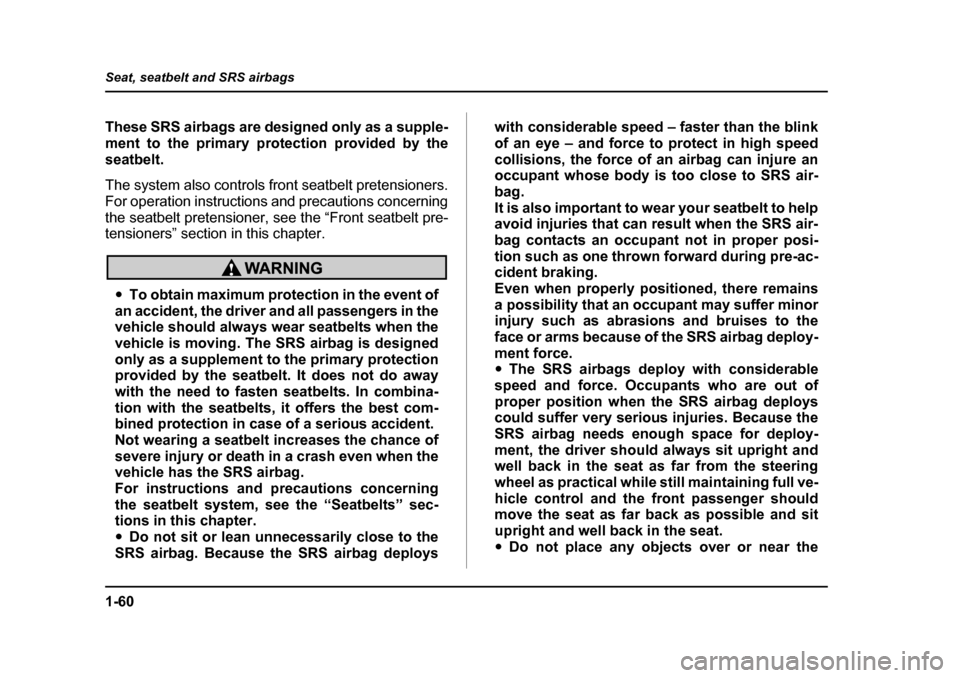
1-60
Seat, seatbelt and SRS airbags
These SRS airbags are designed only as a supple-
ment to the primary protection provided by the
seatbelt.
The system also controls front seatbelt pretensioners.
For operation instructions and precautions concerning
the seatbelt pretensioner, see the “Front seatbelt pre-
tensioners” section in this chapter.
"
To obtain maximum protection in the event of
an accident, the driver and all passengers in the
vehicle should always wear seatbelts when the
vehicle is moving. The SRS airbag is designed
only as a supplement to the primary protection
provided by the seatbelt. It does not do away
with the need to fasten seatbelts. In combina-
tion with the seatbelts, it offers the best com-
bined protection in case of a serious accident.
Not wearing a seatbelt increases the chance of
severe injury or death in a crash even when the
vehicle has the SRS airbag.
For instructions and precautions concerning
the seatbelt system, see the “Seatbelts” sec- tions in this chapter. " Do not sit or lean unnecessarily close to the
SRS airbag. Because the SRS airbag deploys with considerable speed – faster than the blink
of an eye – and force to protect in high speed
collisions, the force of an airbag can injure an
occupant whose body is too close to SRS air-
bag.
It is also important to wear your seatbelt to help
avoid injuries that can result when the SRS air-
bag contacts an occupant not in proper posi-
tion such as one thrown forward during pre-ac-
cident braking.
Even when properly positioned, there remains
a possibility that an occupant may suffer minor
injury such as abrasions and bruises to the
face or arms because of the SRS airbag deploy-
ment force. "
The SRS airbags deploy with considerable
speed and force. Occupants who are out of
proper position when the SRS airbag deploys
could suffer very serious injuries. Because the
SRS airbag needs enough space for deploy-
ment, the driver should always sit upright and
well back in the seat as far from the steering
wheel as practical while still maintaining full ve-
hicle control and the front passenger should
move the seat as far back as possible and sit
upright and well back in the seat." Do not place any objects over or near the
Page 92 of 627
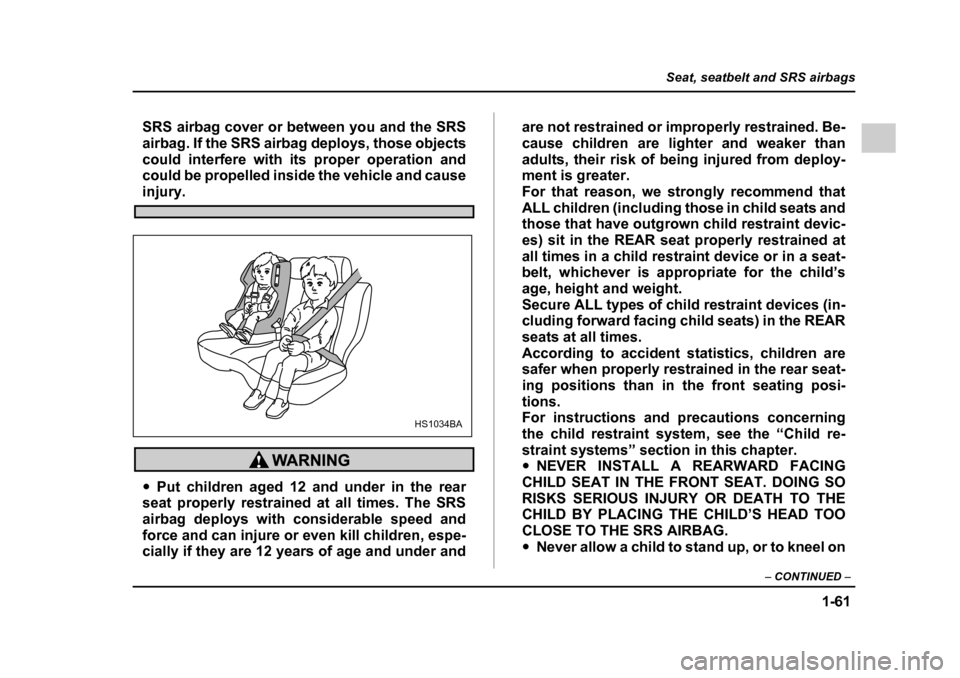
1-61
Seat, seatbelt and SRS airbags
– CONTINUED –
SRS airbag cover or between you and the SRS
airbag. If the SRS airbag deploys, those objects
could interfere with its proper operation and
could be propelled inside the vehicle and cause
injury.
"Put children aged 12 and under in the rear
seat properly restrained at all times. The SRS
airbag deploys with considerable speed and
force and can injure or even kill children, espe-
cially if they are 12 years of age and under and are not restrained or improperly restrained. Be-
cause children are lighter and weaker than
adults, their risk of being injured from deploy-
ment is greater.
For that reason, we strongly recommend that
ALL children (including those in child seats and
those that have outgrown child restraint devic-
es) sit in the REAR seat properly restrained at
all times in a child restraint device or in a seat-
belt, whichever is appropriate for the child’s
age, height and weight.
Secure ALL types of child restraint devices (in-
cluding forward facing child seats) in the REAR
seats at all times.
According to accident statistics, children are
safer when properly restrained in the rear seat-
ing positions than in the front seating posi-tions.
For instructions and precautions concerning
the child restraint system, see the “Child re-
straint systems” section in this chapter. "
NEVER INSTALL A REARWARD FACING
CHILD SEAT IN THE FRONT SEAT. DOING SO
RISKS SERIOUS INJURY OR DEATH TO THE
CHILD BY PLACING THE CHILD’S HEAD TOO
CLOSE TO THE SRS AIRBAG." Never allow a child to stand up, or to kneel on
HS1034BA
Page 93 of 627
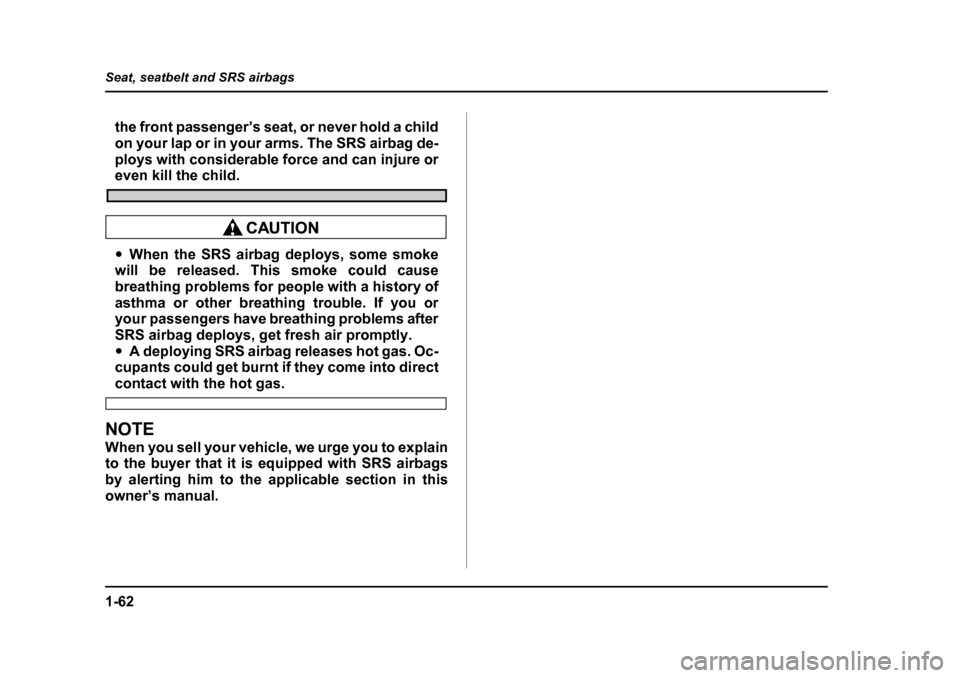
1-62
Seat, seatbelt and SRS airbags
the front passenger’s seat, or never hold a child
on your lap or in your arms. The SRS airbag de-
ploys with considerable force and can injure or
even kill the child.
"
When the SRS airbag deploys, some smoke
will be released. This smoke could cause
breathing problems for people with a history of
asthma or other breathing trouble. If you or
your passengers have breathing problems after
SRS airbag deploys, get fresh air promptly. " A deploying SRS airbag releases hot gas. Oc-
cupants could get burnt if they come into direct
contact with the hot gas.
NOTE
When you sell your vehicle, we urge you to explain
to the buyer that it is equipped with SRS airbags
by alerting him to the applicable section in this owner’s manual.
Page 94 of 627
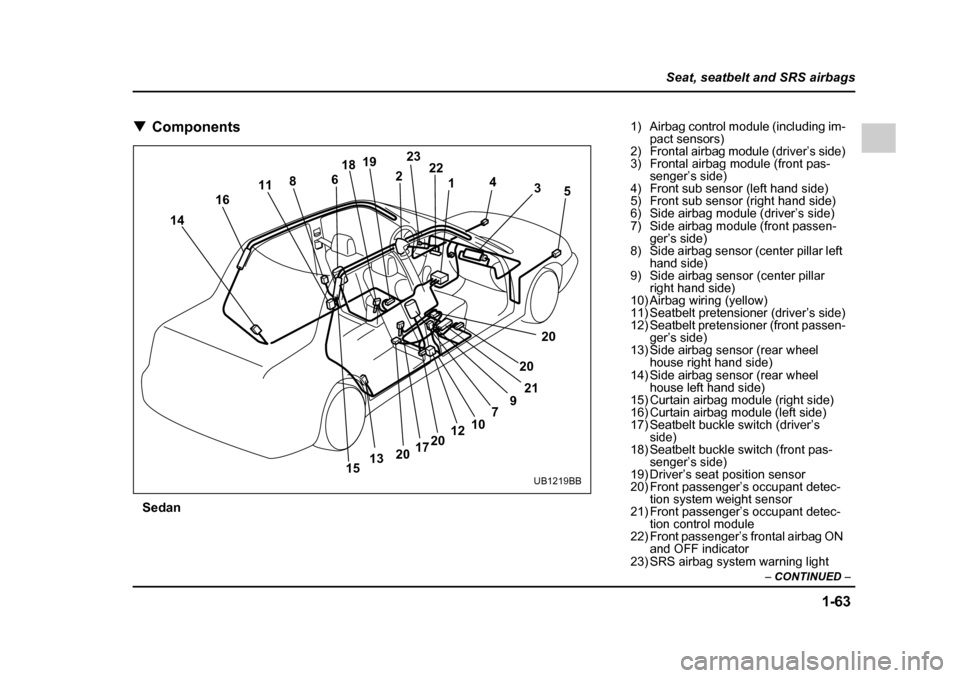
1-63
Seat, seatbelt and SRS airbags
– CONTINUED –
!Components
Sedan
1
2
3
4
5
6 18
19 23
22
8
11
132017
20 12
107
921
20 20
14
16
15
UB1219BB
1) Airbag control module (including im-pact sensors)
2) Frontal airbag module (driver’s side)
3) Frontal airbag module (front pas- senger’s side)
4) Front sub sensor (left hand side)
5) Front sub sensor (right hand side)
6) Side airbag module (driver’s side)
7) Side airbag module (front passen- ger’s side)
8) Side airbag sensor (center pillar left
hand side)
9) Side airbag sensor (center pillar right hand side)
10) Airbag wiring (yellow)
11) Seatbelt pretensioner (driver’s side)
12) Seatbelt pretensioner (front passen- ger’s side)
13) Side airbag sensor (rear wheel house right hand side)
14) Side airbag sensor (rear wheel house left hand side)
15) Curtain airbag module (right side)
16) Curtain airbag module (left side)
17) Seatbelt buckle switch (driver’s side)
18) Seatbelt buckle switch (front pas- senger’s side)
19) Driver’s seat position sensor
20) Front passenger’s occupant detec- tion system weight sensor
21) Front passenger’s occupant detec-
tion control module
22) Front passenger’s frontal airbag ON and OFF indicator
23) SRS airbag system warning light
Page 95 of 627
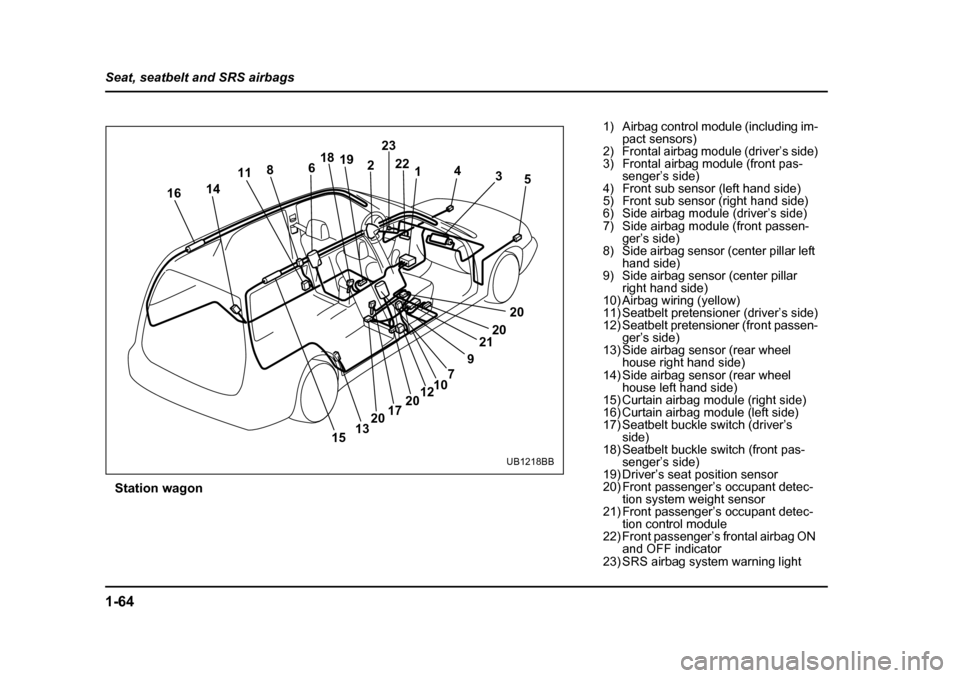
1-64
Seat, seatbelt and SRS airbags
Station wagon
1
2
3
4
5
20
20
21
9
7
10
12
20
17
20
13
6
18
19 23
22
8
11
14
15
16
UB1218BB
1) Airbag control module (including im-
pact sensors)
2) Frontal airbag module (driver’s side)
3) Frontal airbag module (front pas- senger’s side)
4) Front sub sensor (left hand side)
5) Front sub sensor (right hand side)
6) Side airbag module (driver’s side)
7) Side airbag module (front passen- ger’s side)
8) Side airbag sensor (center pillar left
hand side)
9) Side airbag sensor (center pillar right hand side)
10) Airbag wiring (yellow)
11) Seatbelt pretensioner (driver’s side)
12) Seatbelt pretensioner (front passen- ger’s side)
13) Side airbag sensor (rear wheel house right hand side)
14) Side airbag sensor (rear wheel house left hand side)
15) Curtain airbag module (right side)
16) Curtain airbag module (left side)
17) Seatbelt buckle switch (driver’s side)
18) Seatbelt buckle switch (front pas- senger’s side)
19) Driver’s seat position sensor
20) Front passenger’s occupant detec- tion system weight sensor
21) Front passenger’s occupant detec-
tion control module
22) Front passenger’s frontal airbag ON and OFF indicator
23) SRS airbag system warning light
Page 96 of 627
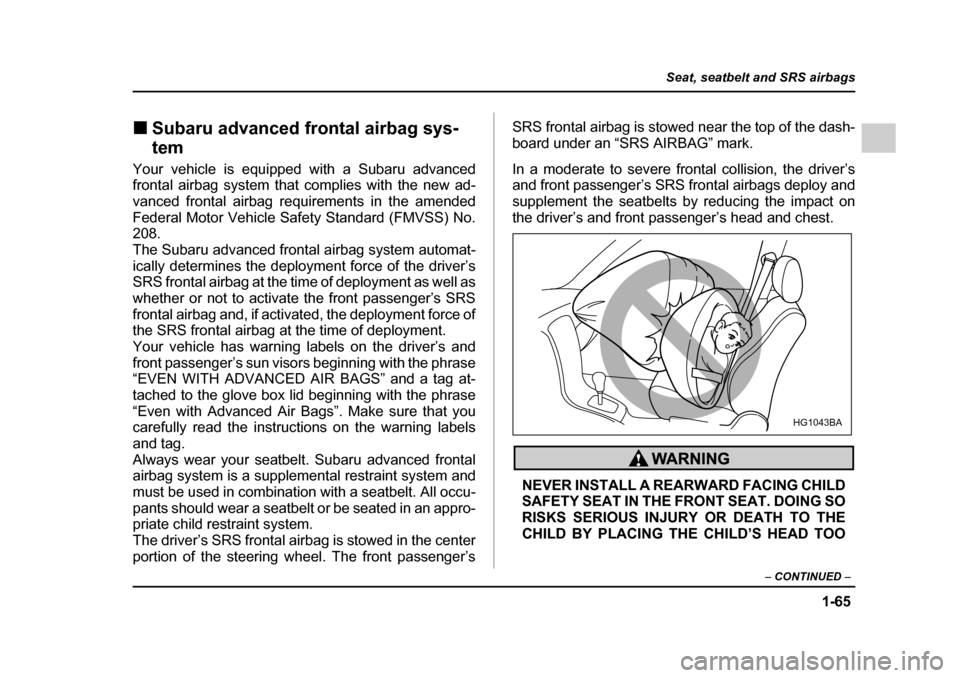
1-65
Seat, seatbelt and SRS airbags
– CONTINUED –
!Subaru advanced frontal airbag sys- tem
Your vehicle is equipped with a Subaru advanced
frontal airbag system that complies with the new ad-
vanced frontal airbag requirements in the amended
Federal Motor Vehicle Safety Standard (FMVSS) No.
208.
The Subaru advanced frontal airbag system automat-
ically determines the deployment force of the driver’s
SRS frontal airbag at the time of deployment as well as
whether or not to activate the front passenger’s SRS
frontal airbag and, if activated, the deployment force of
the SRS frontal airbag at the time of deployment.
Your vehicle has warning labels on the driver’s and
front passenger’s sun visors beginning with the phrase
“EVEN WITH ADVANCED AIR BAGS” and a tag at-
tached to the glove box lid beginning with the phrase
“Even with Advanced Air Bags”. Make sure that you
carefully read the instructions on the warning labels
and tag.
Always wear your seatbelt. Subaru advanced frontal
airbag system is a supplemental restraint system and
must be used in combination with a seatbelt. All occu-
pants should wear a seatbelt or be seated in an appro-
priate child restraint system.
The driver’s SRS frontal airbag is stowed in the center
portion of the steering wheel. The front passenger’s SRS frontal airbag is stowed near the top of the dash-
board under an “SRS AIRBAG” mark.
In a moderate to severe frontal collision, the driver’s
and front passenger’s SRS frontal airbags deploy and
supplement the seatbelts by reducing the impact on
the driver’s and front passenger’s head and chest.
NEVER INSTALL A REARWARD FACING CHILD
SAFETY SEAT IN THE FRONT SEAT. DOING SO
RISKS SERIOUS INJURY OR DEATH TO THE
CHILD BY PLACING THE CHILD’S HEAD TOO
HG1043BA
Page 97 of 627
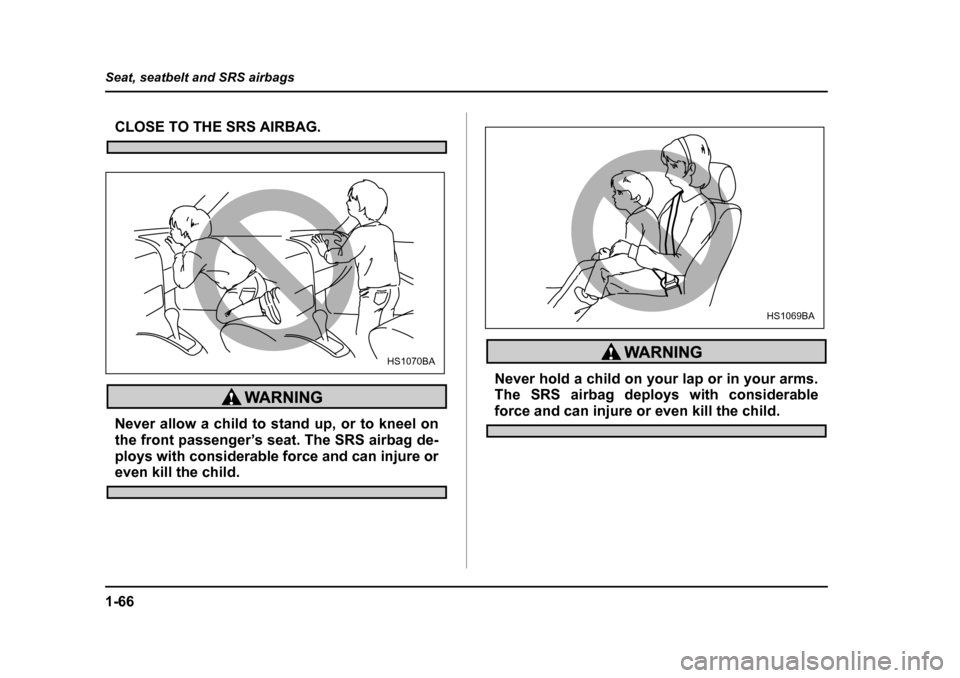
1-66
Seat, seatbelt and SRS airbags
CLOSE TO THE SRS AIRBAG.
Never allow a child to stand up, or to kneel on
the front passenger’s seat. The SRS airbag de-
ploys with considerable force and can injure or
even kill the child.
Never hold a child on your lap or in your arms.
The SRS airbag deploys with considerable
force and can injure or even kill the child.
HS1070BA
HS1069BA
Page 98 of 627
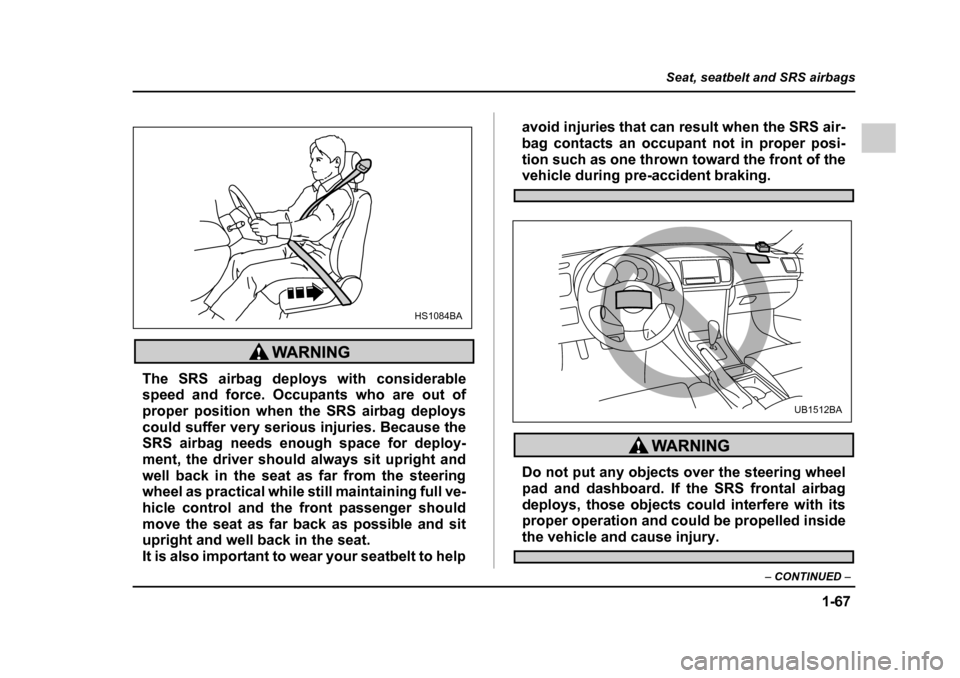
1-67
Seat, seatbelt and SRS airbags
– CONTINUED –
The SRS airbag deploys with considerable
speed and force. Occupants who are out of
proper position when the SRS airbag deploys
could suffer very serious injuries. Because the
SRS airbag needs enough space for deploy-
ment, the driver should always sit upright and
well back in the seat as far from the steering
wheel as practical while still maintaining full ve-
hicle control and the front passenger should
move the seat as far back as possible and sit
upright and well back in the seat.
It is also important to wear your seatbelt to help avoid injuries that can result when the SRS air-
bag contacts an occupant not in proper posi-
tion such as one thrown toward the front of the
vehicle during pre-accident braking.
Do not put any objects over the steering wheel
pad and dashboard. If the SRS frontal airbag
deploys, those objects could interfere with its
proper operation and could be propelled inside
the vehicle and cause injury.
HS1084BA
UB1512BA
Page 99 of 627
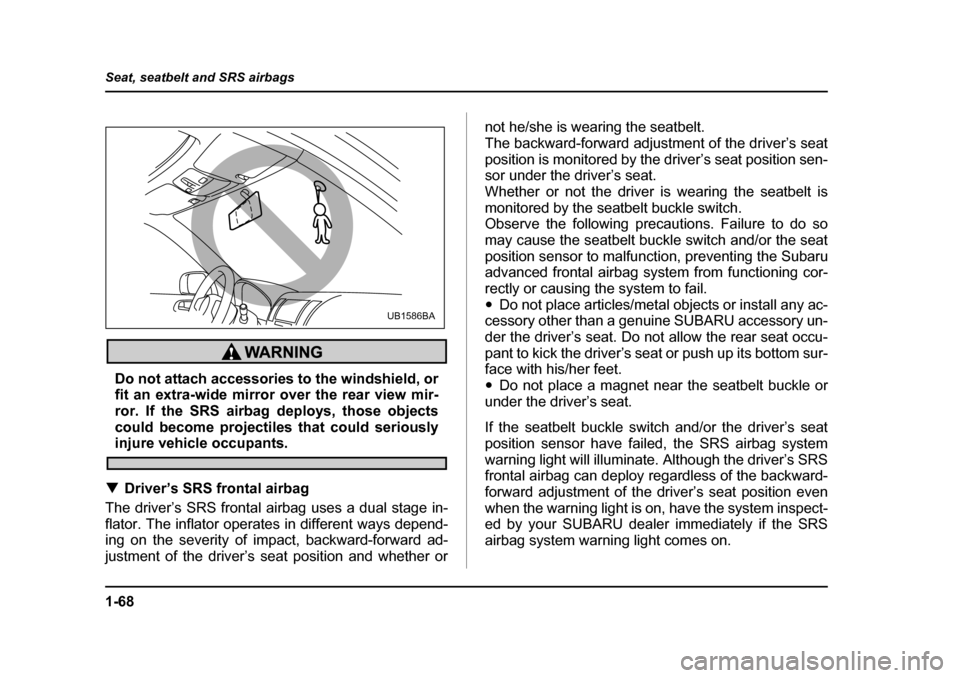
1-68
Seat, seatbelt and SRS airbags
Do not attach accessories to the windshield, or
fit an extra-wide mirror over the rear view mir-
ror. If the SRS airbag deploys, those objects
could become projectiles that could seriously
injure vehicle occupants.
! Driver’s SRS frontal airbag
The driver’s SRS frontal airbag uses a dual stage in-
flator. The inflator operates in different ways depend-
ing on the severity of impact, backward-forward ad-
justment of the driver’s seat position and whether or not he/she is wearing the seatbelt.
The backward-forward adjustment of the driver’s seat
position is monitored by the driver’s seat position sen-
sor under the driver’s seat.
Whether or not the driver is wearing the seatbelt is
monitored by the seatbelt buckle switch.
Observe the following precautions. Failure to do so
may cause the seatbelt buckle switch and/or the seat
position sensor to malfunction, preventing the Subaru
advanced frontal airbag system from functioning cor-
rectly or causing the system to fail."
Do not place articles/metal objects or install any ac-
cessory other than a genuine SUBARU accessory un-
der the driver’s seat. Do not allow the rear seat occu-
pant to kick the driver’s seat or push up its bottom sur-
face with his/her feet. " Do not place a magnet near the seatbelt buckle or
under the driver’s seat.
If the seatbelt buckle switch and/or the driver’s seat
position sensor have failed, the SRS airbag system
warning light will illuminate. Although the driver’s SRS
frontal airbag can deploy regardless of the backward-
forward adjustment of the driver’s seat position even
when the warning light is on, have the system inspect-
ed by your SUBARU dealer immediately if the SRS
airbag system warning light comes on.
UB1586BA
Page 100 of 627

1-69
Seat, seatbelt and SRS airbags
– CONTINUED –
NOTE
The driver’s SRS side airbag, SRS curtain airbag
and seatbelt pretensioner are not controlled by the
Subaru advanced frontal airbag system. !Front passenger’s SRS frontal airbag
The front passenger’s SRS frontal airbag uses a dual
stage inflator. The inflator operates in different ways
depending on the severity of impact and the total load
on the seat.
The total load on the seat is monitored by the passen-
ger’s occupant detection system weight sensor under
the seat.
The detection system monitors the total load on the
seat and, based on this, determines as to whether or
not the front passenger’s SRS frontal airbag should be
activated.
Depending on the weight sensor output, only the driv-
er’s SRS frontal airbag may deploy. This is normal.
Observe the following precautions. Failure to do so
may prevent the Subaru advanced frontal airbag sys-
tem from functioning correctly or cause the system to fail." Do not apply any strong impact to the front passen-
ger’s seat such as by kicking." Do not spill liquid on the front passenger’s seat. If
liquid is spilt, wipe it off immediately. "
Do not remove or disassemble the front passen-
ger’s seat." Do not install any accessory (such as an audio am-
plifier) other than a genuine SUBARU accessory un-
der the front passenger’s seat." Do not place anything (shoes, umbrella, etc.) under
the front passenger’s seat." The front passenger’s seat must not be used with
the head restraint removed. " Do not leave any article including a child restraint
system on the front passenger’s seat or the seatbelt
tongue and buckle engaged when you leave your ve-
hicle. " Do not place a magnet near the seatbelt buckle.
" Do not use front seats with their backward-forward
position and seatback not being locked into place se-
curely. If any of them are not locked securely, adjust
them again. For adjusting procedure, refer to the
“Manual seat” in the front seats section in Chapter 1 in
this owner’s manual. (Models equipped with manualseats only)
If the seatbelt buckle switch and/or passenger’s occu-
pant detection system weight sensor have failed, the
SRS airbag system warning light will illuminate. Have
the system inspected by your SUBARU dealer imme-
diately if the SRS airbag system warning light comeson.